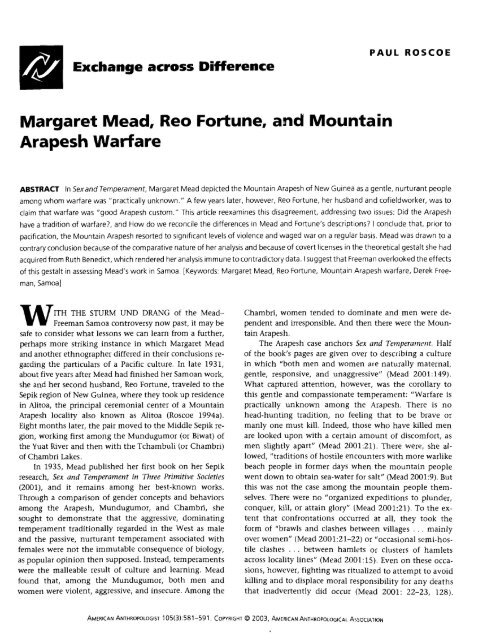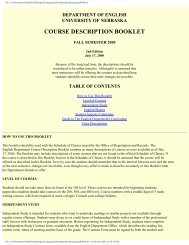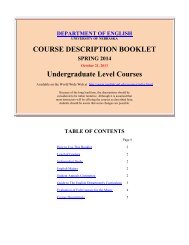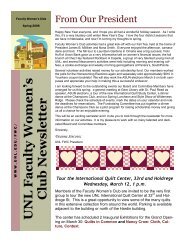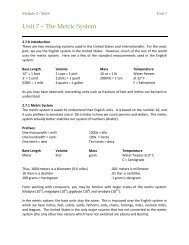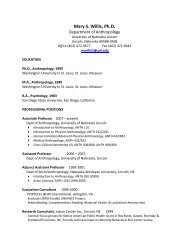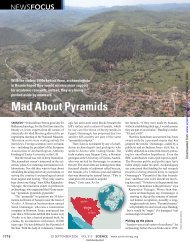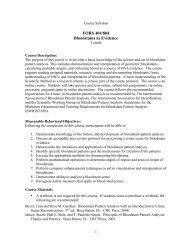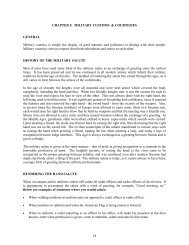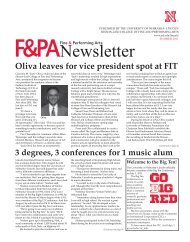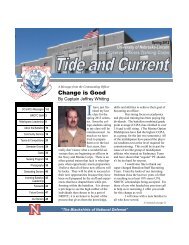Margaret Mead, Reo Fortune, and Mountain Arapesh Warfare
Margaret Mead, Reo Fortune, and Mountain Arapesh Warfare
Margaret Mead, Reo Fortune, and Mountain Arapesh Warfare
Create successful ePaper yourself
Turn your PDF publications into a flip-book with our unique Google optimized e-Paper software.
Exchange across Difference<br />
<strong>Margaret</strong> <strong>Mead</strong>, <strong>Reo</strong> <strong>Fortune</strong>, <strong>and</strong> <strong>Mountain</strong><br />
<strong>Arapesh</strong> <strong>Warfare</strong><br />
PAUL ROSCOE<br />
ABSTRACT In Sex <strong>and</strong> Temperament, <strong>Margaret</strong> <strong>Mead</strong> depicted the <strong>Mountain</strong> <strong>Arapesh</strong> of New Guinea as a gentle, nurturant people<br />
among whom warfare was "practically unknown." A few years later, however, <strong>Reo</strong> <strong>Fortune</strong>, her husb<strong>and</strong> <strong>and</strong> cofieldworker, was to<br />
claim that warfare was "good <strong>Arapesh</strong> custom." This article reexamines this disagreement, addressing two issues: Did the <strong>Arapesh</strong><br />
have a tradition of warfare?, <strong>and</strong> How do we reconcile the differences in <strong>Mead</strong> <strong>and</strong> <strong>Fortune</strong>'s descriptions? I conclude that, prior to<br />
pacification, the <strong>Mountain</strong> <strong>Arapesh</strong> resorted to significant levels of violence <strong>and</strong> waged war on a regular basis. <strong>Mead</strong> was drawn to a<br />
contrary conclusion because of the comparative nature of her analysis <strong>and</strong> because of covert licenses in the theoretical gestalt she had<br />
acquired from Ruth Benedict, which rendered her analysis immune to contradictory data. I suggest that Freeman overlooked the effects<br />
of this gestalt in assessing <strong>Mead</strong>'s work in Samoa. [Keywords: <strong>Margaret</strong> <strong>Mead</strong>, <strong>Reo</strong> <strong>Fortune</strong>, <strong>Mountain</strong> <strong>Arapesh</strong> warfare, Derek Free-<br />
man, Samoa]<br />
WITH THE STURM UND DRANG of the <strong>Mead</strong>-<br />
Freeman Samoa controversy now past, it may be<br />
safe to consider what lessons we can learn from a further,<br />
perhaps more striking instance in which <strong>Margaret</strong> <strong>Mead</strong><br />
<strong>and</strong> another ethnographer differed in their conclusions regarding<br />
the particulars of a Pacific culture. In late 1931,<br />
about five years after <strong>Mead</strong> had finished her Samoan work,<br />
she <strong>and</strong> her second husb<strong>and</strong>, <strong>Reo</strong> <strong>Fortune</strong>, traveled to the<br />
Sepik region of New Guinea, where they took up residence<br />
in Alitoa, the principal ceremonial center of a <strong>Mountain</strong><br />
<strong>Arapesh</strong> locality also known as Alitoa (Roscoe 1994a).<br />
Eight months later, the pair moved to the Middle Sepik region,<br />
working first among the Mundugumor (or Biwat) of<br />
the Yuat River <strong>and</strong> then with the Tchambuli (or Chambri)<br />
of Chambri Lakes.<br />
In 1935, <strong>Mead</strong> published her first book on her Sepik<br />
research, Sex <strong>and</strong> Temperament in Three Primitive Societies<br />
(2001), <strong>and</strong> it remains among her best-known works.<br />
Through a comparison of gender concepts <strong>and</strong> behaviors<br />
among the <strong>Arapesh</strong>, Mundugumor, <strong>and</strong> Chambri, she<br />
sought to demonstrate that the aggressive, dominating<br />
temperament traditionally regarded in the West as male<br />
<strong>and</strong> the passive, nurturant temperament associated with<br />
females were not the immutable consequence of biology,<br />
as popular opinion then supposed. Instead, temperaments<br />
were the malleable result of culture <strong>and</strong> learning. <strong>Mead</strong><br />
found that, among the Mundugumor, both men <strong>and</strong><br />
women were violent, aggressive, <strong>and</strong> insecure. Among the<br />
Chambri, women tended to dominate <strong>and</strong> men were dependent<br />
<strong>and</strong> irresponsible. And then there were the <strong>Mountain</strong><br />
<strong>Arapesh</strong>.<br />
The <strong>Arapesh</strong> case anchors Sex <strong>and</strong> Temperament. Half<br />
of the book's pages are given over to describing a culture<br />
in which "both men <strong>and</strong> women are naturally maternal,<br />
gentle, responsive, <strong>and</strong> unaggressive" (<strong>Mead</strong> 2001:149).<br />
What captured attention, however, was the corollary to<br />
this gentle <strong>and</strong> compassionate temperament: "<strong>Warfare</strong> is<br />
practically unknown among the <strong>Arapesh</strong>. There is no<br />
head-hunting tradition, no feeling that to be brave or<br />
manly one must kill. Indeed, those who have killed men<br />
are looked upon with a certain amount of discomfort, as<br />
men slightly apart" (<strong>Mead</strong> 2001:21). There were, she allowed,<br />
"traditions of hostile encounters with more warlike<br />
beach people in former days when the mountain people<br />
went down to obtain sea-water for salt" (<strong>Mead</strong> 2001:9). But<br />
this was not the case among the mountain people themselves.<br />
There were no "organized expeditions to plunder,<br />
conquer, kill, or attain glory" (<strong>Mead</strong> 2001:21). To the extent<br />
that confrontations occurred at all, they took the<br />
form of "brawls <strong>and</strong> clashes between villages . . . mainly<br />
over women" (<strong>Mead</strong> 2001:21-22) or "occasional semi-hostile<br />
clashes . . . between hamlets or clusters of hamlets<br />
across locality lines" (<strong>Mead</strong> 2001:15). Even on these occasions,<br />
however, fighting was ritualized to attempt to avoid<br />
killing <strong>and</strong> to displace moral responsibility for any deaths<br />
that inadvertently did occur (<strong>Mead</strong> 2001: 22-23, 128).<br />
AMERICAN ANTHROPOLOGIST 105(3):581-591. COPYRIGHT © 2003, AMERICAN ANTHROPOLOGICAL ASSOCIATION
582 American Anthropologist • Vol. 105, No. 3 • September 2003<br />
Subsequently, <strong>Mead</strong> was to reiterate this picture, claiming<br />
that "the <strong>Arapesh</strong> have no pattern of real warfare"<br />
(1937:35) <strong>and</strong> that warfare was limited to "skirmishes between<br />
hamlets or clusters of hamlets in occasional conflicts<br />
over the elopement or theft of a woman" (1961:1438).<br />
<strong>Mead</strong> <strong>and</strong> <strong>Fortune</strong>'s marriage barely survived their<br />
Sepik fieldwork <strong>and</strong> their chance encounter with Gregory<br />
Bateson, who had just returned for further field study<br />
among the Iatmul of the Middle Sepik. On their return<br />
from New Guinea in 1933, <strong>Mead</strong> <strong>and</strong> <strong>Fortune</strong> divorced<br />
<strong>and</strong>, in 1936, one year after their divorce was finalized,<br />
<strong>Mead</strong> <strong>and</strong> Bateson were married en route to fieldwork in<br />
Bali (Howard 1984:180-187).<br />
All of this is well known, but perhaps less known is<br />
what happened to <strong>Fortune</strong> after he departed <strong>Mead</strong>'s life.<br />
Two years after the separation, he returned to New Guinea,<br />
to the Eastern Highl<strong>and</strong>s, to conduct fieldwork among the<br />
Kamano who were at the time under minimal colonial<br />
control (McLean 1992). <strong>Warfare</strong> was still intense—<strong>Fortune</strong><br />
witnessed two deadly ambushes (n.d.a:90)—<strong>and</strong> in late<br />
July 1935, following a four-day battle in Komonka, the local<br />
Australian patrol post forced him to withdraw. Retreating<br />
to the coast, he found <strong>Mead</strong> had sent him a copy of<br />
Sex <strong>and</strong> Temperament, <strong>and</strong> after reading it he decided, in<br />
his own words, to go "back to the <strong>Arapesh</strong> country to<br />
check a point or two" (<strong>Fortune</strong> n.d.b:4, also 1937:2).<br />
For reasons that are unclear, he did not return to Alitoa<br />
itself but spent three months with Suabybys clan in<br />
Liwo, a <strong>Mountain</strong> <strong>Arapesh</strong> locality about four kilometers<br />
north of Alitoa (<strong>Fortune</strong> n.d.b:5). Drawing primarily on<br />
data from this second visit, he then published an article<br />
entitled simply "<strong>Arapesh</strong> <strong>Warfare</strong>," in which he courteously<br />
but flatly rejected <strong>Mead</strong>'s claims about <strong>Arapesh</strong> pacificity<br />
(see also 1939:36).<br />
<strong>Warfare</strong> was good <strong>Arapesh</strong> custom. It was distinguished<br />
from the sometimes heated quarrels between the turbulent<br />
clans of a single sovereign locality by its scale, its<br />
determination, <strong>and</strong> by its traditions <strong>and</strong> conventions.<br />
[<strong>Fortune</strong> 1939:27]<br />
To support his claim, he provided a war leader's speech<br />
rallying the clans of a locality for a forthcoming battle <strong>and</strong><br />
informant accounts of an intraclan homicide, a feud among<br />
the clans of Liwo locality, <strong>and</strong> an interlocality battle at the<br />
traditional war ground of Nuberum-Mugueruhunum.<br />
<strong>Mead</strong> never publicly responded to <strong>Fortune</strong>'s critique.<br />
In later publications, she did allow that they had weaponry,<br />
war-related ritual, <strong>and</strong> "a sort of informal warfare"<br />
(1947:180, 1940:437), but the differences between the two<br />
characterizations remained stark. <strong>Mead</strong> continued to assert<br />
that "they engage very little in warfare" (1949a:67);<br />
"there were always strong sanctions against [war], because<br />
of the outst<strong>and</strong>ing feast plans" (1947-.180); <strong>and</strong> when<br />
fighting did occur, the "aim was wide <strong>and</strong> low" <strong>and</strong> the<br />
fight "was customarily discontinued as soon as blood was<br />
drawn" (1940:437).<br />
<strong>Mead</strong> <strong>and</strong> <strong>Fortune</strong>'s differences over <strong>Mountain</strong> <strong>Arapesh</strong><br />
warfare have not gone unnoticed <strong>and</strong>, at the height of the<br />
<strong>Mead</strong>-Freeman controversy, were occasionally mentioned<br />
as an aside, even in the media. Yet the case never received<br />
close scrutiny, which is perhaps surprising because, superficially<br />
at least, it seems as relevant to Freeman's thesis as<br />
the Samoan case. For one thing, like <strong>Mead</strong>'s work in Samoa,<br />
Sex <strong>and</strong> Temperament had a great deal of influence on U.S.<br />
anthropology <strong>and</strong>, perhaps, an even greater impact on<br />
U.S. social science in general. A survey of 112 introductory<br />
anthropology textbooks (Hays 1999:504), for example,<br />
found 44 percent citing <strong>Mead</strong>'s work on the <strong>Arapesh</strong>, compared<br />
to the 64 percent that cited her Samoan work. An<br />
analysis of 27 introductory sociology texts (Hays 1997:97<br />
n. 6) found that more than half (15) cited Sex <strong>and</strong> Temperament,<br />
compared to just one mention of Coming of Age in<br />
Samoa (1928). Sex <strong>and</strong> Temperament's continuing impact is<br />
also reflected in its several republications (1950, 1963, <strong>and</strong><br />
2001), its numerous reprintings, <strong>and</strong> its continuing presence<br />
on the syllabi for college undergraduates in anthropology,<br />
psychology, sociology, human development, <strong>and</strong><br />
general education.<br />
The further relevance of the <strong>Arapesh</strong> case to the Samoan<br />
controversy is that it raises the "observer effect" to<br />
especially sharp relief. During most of their <strong>Arapesh</strong> research,<br />
the pair occupied the same field house <strong>and</strong> studied<br />
the same people at the same moment in time. The only<br />
difference is that, two years later, <strong>Fortune</strong> spent a further<br />
three months in Liwo, Alitoa's neighbor to the immediate<br />
north. The <strong>Arapesh</strong> case, in sum, is one of those rare instances<br />
when the "monological authority" of the ethnographer<br />
is radically undermined (Roscoe 1995:497-498).<br />
The two other ethnographic case studies in Sex <strong>and</strong> Temperament,<br />
examining the Mundugumor <strong>and</strong> Chambri, have<br />
already received close scrutiny (Gewertz 1981; McDowell<br />
1991). In this article, I reconsider the <strong>Mountain</strong> <strong>Arapesh</strong>,<br />
the third support for <strong>Mead</strong>'s argument in Sex <strong>and</strong> Temperament.<br />
1 With the aid of <strong>Mead</strong> <strong>and</strong> <strong>Fortune</strong>'s publications<br />
<strong>and</strong> unpublished papers <strong>and</strong> my own fieldwork among the<br />
neighboring Yangoru Boiken, who appear to share a close<br />
genetic <strong>and</strong> cultural heritage with the <strong>Mountain</strong> <strong>Arapesh</strong><br />
(Roscoe 1989, 1994b), I shall be concerned with two issues.<br />
First, did the <strong>Arapesh</strong> have a tradition of warfare or<br />
not; <strong>and</strong> second, how do we reconcile the differences in<br />
<strong>Mead</strong> <strong>and</strong> <strong>Fortune</strong>'s descriptions? I argue that <strong>Fortune</strong><br />
more accurately depicted <strong>Mountain</strong> <strong>Arapesh</strong> warfare. Prior<br />
to pacification, the <strong>Mountain</strong> <strong>Arapesh</strong> resorted to significant<br />
levels of violence <strong>and</strong>, by almost any definition of the<br />
term, they waged war on a regular basis. From this conclusion,<br />
I move to consider the more interesting issue of how<br />
<strong>and</strong> why <strong>Mead</strong> "got it wrong." I suggest that the answer is<br />
complex. In part, it was a product of her comparative<br />
framework: In comparison to the Mundugumor <strong>and</strong> Chambri,<br />
the <strong>Mountain</strong> <strong>Arapesh</strong> appeared to her to be relatively<br />
peaceful. However, it was also a product of covert theoretical<br />
licenses in the theoretical gestalt she had acquired<br />
from Ruth Benedict—factors Freeman seems to have overlooked<br />
in assessing <strong>Mead</strong>'s work in Samoa.
MOUNTAIN ARAPESH WARFARE<br />
My first reason for doubting that the <strong>Mountain</strong> <strong>Arapesh</strong><br />
were as peaceful as <strong>Mead</strong> portrayed them stems my own<br />
fieldwork amongst the Yangoru Boiken, a neighboring<br />
people who live immediately to the southeast. The Yangoru<br />
Boiken most definitely had a tradition of war: They<br />
ambushed slumbering hamlets under cover of night; they<br />
attacked parties of their enemies at work in the gardens or<br />
en route to coastal trade friends; <strong>and</strong>, from time to time,<br />
they fought prearranged battles at designated war grounds<br />
on the borders with their enemies. Much of this fighting<br />
was limited to their main settlements in the southern<br />
foothills of the Prince Alex<strong>and</strong>er range, but it was also<br />
waged from their satellite settlements in the peakl<strong>and</strong>s. At<br />
contact, these satellites lined the <strong>Mountain</strong> <strong>Arapesh</strong> border:<br />
Pitu, Ain, Hwielembora, <strong>and</strong> Meiwungu were all just<br />
five to ten kilometers from <strong>Mead</strong> <strong>and</strong> <strong>Fortune</strong>'s field site in<br />
Alitoa ceremonial center <strong>and</strong> even closer to other <strong>Mountain</strong><br />
<strong>Arapesh</strong> settlements. Thus, if the <strong>Mountain</strong> <strong>Arapesh</strong><br />
indeed had no established tradition of warfare, it is difficult<br />
to imagine that they would have survived for long<br />
against Yangoru Boiken attacks. Moreover, had the Yangoru<br />
Boiken somehow failed to exterminate them, the<br />
"Plains" <strong>Arapesh</strong>, who "fight with spears" <strong>and</strong> live immediately<br />
to their south, or the Abelam, "a gay artistic headhunting<br />
people" (<strong>Mead</strong> 2001:10, 11) whose nearest villages<br />
are just 15 kilometers to the southeast, surely would<br />
have finished the job.<br />
There is another reason, though, to doubt that the<br />
<strong>Mountain</strong> <strong>Arapesh</strong> were essential pacifists. Scattered through<br />
both <strong>Fortune</strong> <strong>and</strong> <strong>Mead</strong>'s published <strong>and</strong> unpublished<br />
works is evidence of a significant level of homicidal violence,<br />
most of which constituted warfare by any definition.<br />
To begin with, there is a "census of the war records of<br />
individual, grey-headed old men" that <strong>Fortune</strong> conducted<br />
during his return visit to <strong>Mountain</strong> <strong>Arapesh</strong> territory: He<br />
found "that approximately fifty percent of them claimed<br />
one or more war homicides each to his credit. The others<br />
disclaimed personal homicides" (1939:27). Neither in his<br />
published work nor among his surviving papers did <strong>Fortune</strong><br />
mention the site or size of this census, beyond a comment<br />
that it was "of the old men of Liwo <strong>and</strong> of Bugabehem<br />
localities" (<strong>Fortune</strong> n.d.c:51/118).<br />
These old men were all grey beards <strong>and</strong> gr<strong>and</strong>fathers, <strong>and</strong><br />
men who had passed, at best estimate, the first 30 ot 40<br />
years of their lives free from the subsequent European<br />
subjugation <strong>and</strong> the subsequent outlawry of native warfare.<br />
Approximately every alternate old man had one or<br />
more homicides to his credit, but every other alternate old<br />
man had none. They all lent a very grave courtesy to replying<br />
to the writer's questions. [<strong>Fortune</strong> n.d.c:51/118; see<br />
also n.d.c:62]<br />
In 1934, patrol officer Ken Thomas (1934:87) censused<br />
97 adult males in Liwo <strong>and</strong> Bugabehem localities, so<br />
it is unlikely that "the old men" of these two localities exceeded<br />
30. Too many unknown demographic <strong>and</strong> historical<br />
variables intervene to make any defensible guess about<br />
Roscoe • <strong>Mountain</strong> <strong>Arapesh</strong> <strong>Warfare</strong> 583<br />
the mortality rate in <strong>Arapesh</strong> violence from these data, but<br />
if <strong>Fortune</strong>'s sample was representative, then it was clearly<br />
significant.<br />
This conclusion is buttressed by two further sources of<br />
information. The first is <strong>Fortune</strong>'s estimate that, in the<br />
"inter-municipal affrays" that occasionally followed a married<br />
woman's elopement, "about four persons were killed<br />
<strong>and</strong> several wounded" (1947:253). The second is a tally of<br />
<strong>Arapesh</strong> killings <strong>and</strong> woundings scattered throughout<br />
<strong>Mead</strong> <strong>and</strong> <strong>Fortune</strong>'s published <strong>and</strong> unpublished writings.<br />
These indicate that, over the space of about twenty-five<br />
years (1900-26), members of Alitoa locality participated in<br />
killing at least 11 people (one of them a member of Alitoa)<br />
<strong>and</strong> wounding 12 others (four of them members of Alitoa),<br />
while they themselves sustained at least eight deaths<br />
<strong>and</strong> one wounding at the h<strong>and</strong>s of other localities. 2 Between<br />
1880 <strong>and</strong> 1920, members of Liwo locality participated<br />
in killing at least 16 people (ten of them members of<br />
Liwo) <strong>and</strong> seriously wounding 23 others (18 of them from<br />
Liwo), while themselves suffering at least eight deaths <strong>and</strong><br />
five serious woundings by other localities. More than 90<br />
percent of these killings <strong>and</strong> over 80 percent of the woundings<br />
occurred over about 15 years, between 1908 <strong>and</strong> 1920. 3<br />
To look at it in another way, between about 1900-25,<br />
Alitoa, a locality of 216 people in 1932, <strong>and</strong> Liwo, a locality<br />
censused at 181 people in 1934, were each participating<br />
in the killing, on average, of at least one person about<br />
every other year <strong>and</strong> the serious wounding of at least one<br />
more (<strong>Mead</strong> 1947:268, 389-395; Thomas 1934:87). 4 At<br />
first blush, this might not seem an excessive rate, but<br />
these figures represent a mortality in war of at least ten<br />
percent of all deaths. This compares to rates of 20-35 percent<br />
in the Eastern Highl<strong>and</strong>s, where fighting appears to<br />
have reached its deadliest intensity in all of New Guinea<br />
(e.g., Berndt 1973:397, 399; Hayano 1972:287; Robbins<br />
1982:211).<br />
These are conservative figures: they represent only<br />
those cases that appear in <strong>Mead</strong> <strong>and</strong> <strong>Fortune</strong>'s published<br />
<strong>and</strong> unpublished papers. This does not mean, though,<br />
that they can be taken as minimum estimates of <strong>Arapesh</strong><br />
violence. Ferguson <strong>and</strong> Whitehead (1992) have cogently<br />
argued that colonial expansion probably intensified "tribal"<br />
fighting at the edge of Empire, distorting the indigenous<br />
patterns reported in historical <strong>and</strong> ethnographic documents.<br />
In the <strong>Arapesh</strong> case, the most likely European influence<br />
to elevate homicide levels was introduced disease<br />
(Allen 1989:41-46). Since the <strong>Arapesh</strong> attributed fatal disease<br />
to sorcery, it is possible that deaths from introduced<br />
diseases could have inflated revenge killings with the<br />
spear—as seems to have occurred among the Etoro of the<br />
Papuan Plateau (Kelly 1977:30-31). According to <strong>Mead</strong>, a<br />
"few years" before she <strong>and</strong> <strong>Fortune</strong> arrived, the <strong>Mountain</strong><br />
<strong>Arapesh</strong> had suffered an epidemic of what was probably<br />
influenza, but this could hardly have elevated homicide<br />
rates of a decade or more earlier (<strong>Mead</strong> 1947:345 n.4). Influenza<br />
outbreaks cannot be ruled out in earlier years,<br />
though, <strong>and</strong> around 1890 a smallpox epidemic may have
584 American Anthropologist • Vol. 105, No. 3 • September 2003<br />
reached the Maprik region, some twenty-five kilometers to<br />
the southwest, possibly affecting them as well (Allen<br />
1989:43).<br />
There is reason to doubt, though, that these European<br />
diseases would have greatly magnified the killing rates<br />
computed above. For one thing, if the 1890 smallpox epidemic<br />
did reach Alitoa <strong>and</strong> Liwo, any wave of revenge killings<br />
likely would have played out by 1900, when all but<br />
two of the listed killings begin. For another, at least within<br />
a locality moiety, the <strong>Arapesh</strong> preferred to avenge sorcery<br />
with sorcery, not with the spear (<strong>Fortune</strong> n.d.d:n.p.,<br />
n.d.e:73/15, 74, n.d.f:7; <strong>Mead</strong> 1947:179). As <strong>Fortune</strong> once<br />
remarked, "sorcery [is] an inside job" (n.d.e:n,p., n.d.g:4).<br />
Sorcery attributed to the opposite moiety of a locality or to<br />
other localities was more likely to be avenged with the<br />
spear or arrow, but the only such case I have been able to<br />
locate involved a Liwo man's murder of an Alitoan child<br />
to revenge a death due not to disease but to a fall from a<br />
tree.<br />
However European disease may have inflated the<br />
number of killings listed in <strong>Mead</strong> <strong>and</strong> <strong>Fortune</strong>'s accounts,<br />
its effects would have been significantly offset by another<br />
European-induced process: pacification. Pacification of<br />
the <strong>Mountain</strong> <strong>Arapesh</strong> was probably well underway by the<br />
mid-to-late 1910s, but it took several more years fully to<br />
take hold (Roscoe 2002:xxi). In other words, a significant<br />
proportion of the killings <strong>and</strong> woundings in the rates calculated<br />
above took place at a time when <strong>Arapesh</strong> warfare<br />
was being actively suppressed. In all, it seems safe to conclude<br />
that the computed rates of killing <strong>and</strong> wounding for<br />
Alitoa <strong>and</strong> Liwo probably do not overemphasize the scale<br />
of <strong>Arapesh</strong> violence.<br />
A final issue to be resolved, then, is whether this violence<br />
rose to the level of warfare. <strong>Mead</strong> appears to have<br />
thought of warfare as activity "in which defined groups<br />
engage in purposeful, organized <strong>and</strong> socially sanctioned<br />
combat involving killing each other. . . . <strong>Warfare</strong> exists if<br />
the conflict is organized, <strong>and</strong> socially sanctioned <strong>and</strong> the<br />
killing is not regarded as murder" (1968:215). If the incidents<br />
in Alitoa <strong>and</strong> Liwo did not meet these specifications,<br />
then perhaps she could legitimately claim that the <strong>Mountain</strong><br />
<strong>Arapesh</strong> had no established tradition of warfare. To<br />
the best of my knowledge, <strong>Mead</strong> never chose to explain<br />
her differences with <strong>Fortune</strong> on these grounds, <strong>and</strong> there<br />
are references to war <strong>and</strong> warfare scattered throughout her<br />
field notes, A closer examination of the incidents making<br />
up the Alitoa <strong>and</strong> Liwo rates, moreover, suggests that the<br />
majority did constitute war—by <strong>Mead</strong>'s or almost any<br />
other definition.<br />
<strong>Fortune</strong> (1939:27-28, 32-33) distinguished three levels<br />
of <strong>Arapesh</strong> conflict. The first involved intraclan violence,<br />
which was morally repudiated <strong>and</strong> apparently rare:<br />
<strong>Fortune</strong> himself knew of only one case (1939:27-28), <strong>and</strong><br />
none of the documented cases of woundings seem to have<br />
fallen into this category. The second type of conflict occurred<br />
between clans of the same locality. In these confrontations,<br />
killings <strong>and</strong> woundings did not provoke the<br />
same level of moral repudiation as intraclan homicides.<br />
Nonetheless, the preference was to resolve quarrel^ at this<br />
level with sorcery rather than with the arrow or spear. Even<br />
when weapons were taken up, there is some evidence that<br />
restraint was exercised (1939:32-33). Significantly, perhaps,<br />
the Alitoa <strong>and</strong> Liwo figures indicate that woundings<br />
were more common than killings in this type of combat:<br />
43 percent of the woundings but only 26 percent of the<br />
killings were perpetrated between clans of the same locality.<br />
By any definition—not just <strong>Mead</strong>'s—intraclan homicide<br />
would be difficult to categorize as "war"; in most lexicons,<br />
it constitutes murder. Some definitions might<br />
classify the second type of violence as "feud" rather than<br />
"war" on the basis that it was "a type of armed combat occurring<br />
within a political community" (Otterbein 1973:<br />
923, emphasis added). It would be difficult, though, to extend<br />
this definitional claim to the third type of confrontation,<br />
conflicts between clans of different localities, These<br />
actions appear to have been morally acceptable if not extolled;<br />
some even involved prearranged confrontations on<br />
traditional battlefields located on locality borders (<strong>Fortune</strong><br />
1939:31,34-36); <strong>and</strong> they accounted for the majority of serious<br />
<strong>Arapesh</strong> violence—71 percent of the killings <strong>and</strong> 57<br />
percent of the woundings in the Alitoa <strong>and</strong> Liwo figures. It<br />
is doubtful, therefore, that <strong>Mead</strong> would or could have considered<br />
the violence in this third type of conflict to be<br />
anything other than war.<br />
STUDYING THE MOUNTAIN ARAPESH<br />
In sum, there are several reasons why <strong>Mead</strong>'s conclusion<br />
that warfare was "practically unknown" among the <strong>Mountain</strong><br />
<strong>Arapesh</strong> is untenable. The more interesting anthropological<br />
issue, though, is how she <strong>and</strong> <strong>Fortune</strong>, working at<br />
the same spatial <strong>and</strong> temporal junctures, could arrive at<br />
such diametrically opposed conclusions, <strong>and</strong> why it was<br />
<strong>Mead</strong>, <strong>and</strong> not <strong>Fortune</strong>, who was led astray. The obvious<br />
possibility is also the most provocative, <strong>and</strong> it was implied<br />
by a criticism to which <strong>Mead</strong> herself alluded. In the preface<br />
to the 1950 edition of Sex <strong>and</strong> Temperament, she wrote<br />
that some readers of the first edition (1935) had felt that<br />
her results formed " 'too beautiful' a pattern" (2001:xxvi).<br />
Supposedly, she <strong>and</strong> <strong>Fortune</strong> had chosen the <strong>Arapesh</strong>,<br />
Mundugumor, <strong>and</strong> Chambri by chance, <strong>and</strong>, yet, along<br />
with the U.S. case, they exactly mapped all four possible<br />
permutations of gender <strong>and</strong> of nurturance <strong>and</strong> aggression:<br />
the Mundugumor—male aggressive, female aggressive; the<br />
U.S.—male aggressive, female nurturant; the Chambri—<br />
male nurturant, female aggressive; <strong>and</strong> the <strong>Mountain</strong><br />
<strong>Arapesh</strong>—male nurturant, female nurturant. "This, many<br />
readers felt, was too much. It was too pretty. I must have<br />
found what I was looking for" (2001:xxvi).<br />
<strong>Mead</strong> provides no source for this criticism, <strong>and</strong> I have<br />
been unable to locate any such comment in published<br />
work. Perhaps she was responding to gossip. Whatever the<br />
case, her readers were probably being polite. What many<br />
doubtless meant was that she needed <strong>Mountain</strong> <strong>Arapesh</strong>
males <strong>and</strong> females to be peaceful <strong>and</strong> nurturant if she were<br />
to make her theoretical case, <strong>and</strong> since their traditions of<br />
warfare contradicted her thesis, she camouflaged the evidence.<br />
To put it baldly, <strong>Mead</strong> fudged the data.<br />
For several reasons, this conclusion is implausible. As<br />
<strong>Mead</strong> recounted matters, her theory emerged from her<br />
data, not the other way round. It was not until she was living<br />
with the Chambri—following her research among the<br />
<strong>Arapesh</strong> <strong>and</strong> Mundugumor—that she eventually developed<br />
the temperamental model into which she could fit<br />
U.S. culture <strong>and</strong> these three Sepik cultures (<strong>Mead</strong> 1972:<br />
216-220; see also Bateson 1994:160-168; Howard 1984:<br />
154_164). Of course, this claim might be ex post facto rationalization<br />
or obscuration, but there is compelling evidence<br />
to the contrary in letters she wrote from Alitoa, before<br />
she <strong>and</strong> <strong>Fortune</strong> had ever set foot in the Middle Sepik.<br />
From a bulletin sent to friends at home, a couple of weeks<br />
after her arrival in Alitoa:<br />
They are very quiet <strong>and</strong> unaggressive. [<strong>Mead</strong> 1932a:2]<br />
From a letter to Raymond Firth, the next day:<br />
The people themselves are gentle, amiable, non-controversial<br />
<strong>and</strong> non-aggressive—much nicer than the Manus<br />
or the Dobuans. .. . Their confidence <strong>and</strong> friendliness is<br />
most disarming. [<strong>Mead</strong> 1932b]<br />
In other words, <strong>Mead</strong> had already arrived at her notion of<br />
the gentle, nonaggressive <strong>Arapesh</strong> while she was still studying<br />
them—within a few days, in fact, of making their acquaintance.<br />
If <strong>Mead</strong> had seriously intended to obscure the reality<br />
of <strong>Mountain</strong> <strong>Arapesh</strong> warfare, in fact, we should have to<br />
wonder why she made no attempt to shovel under the carpet<br />
the evidence she had gathered pointing to <strong>Arapesh</strong> aggression<br />
<strong>and</strong> violence. As Freeman (1999:9, 212) has noted<br />
in dismissing the idea that she deliberately falsified her Samoan<br />
data, she made her papers available for public scrutiny<br />
in the Library of Congress. Moreover, almost everything<br />
in her field notes concerning <strong>Arapesh</strong> violence also<br />
appears in one place or another in her published work. Indeed,<br />
in chapter 8 of Sex <strong>and</strong> Temperament—"The <strong>Arapesh</strong><br />
ideal <strong>and</strong> those who deviate from it"—<strong>Mead</strong> explicitly<br />
drew attention to instances of aggression <strong>and</strong> violence. Finally,<br />
had she deliberately intended to mislead, she would<br />
have had to contend with the knowledge that <strong>Fortune</strong><br />
could publicly refute her claims—as indeed he did in his<br />
American Anthropologist article, "<strong>Arapesh</strong> <strong>Warfare</strong>." Certainly,<br />
<strong>Fortune</strong> found numerous faults with Sex <strong>and</strong> Temperament,<br />
<strong>and</strong> scattered through his papers are the pages of<br />
several incomplete drafts of a manuscript attempting to<br />
account for inconsistencies between <strong>Mead</strong>'s <strong>and</strong> his own<br />
research. Nowhere among the pages that have survived,<br />
however, does he make any suggestion that <strong>Mead</strong> deliberately<br />
mislead her readers.<br />
<strong>Fortune</strong>'s position, as best can be judged from partial<br />
evidence, was that <strong>Mead</strong> had failed to grasp the historical<br />
<strong>and</strong> cultural context of what she observed in Alitoa. In particular,<br />
he felt she had incautiously taken the ethnographic<br />
Roscoe • <strong>Mountain</strong> <strong>Arapesh</strong> <strong>Warfare</strong> 585<br />
present as evidence for the ethnographic past, overlooking<br />
changes that 15-25 years of pacification had wrought. In<br />
support of hei image of <strong>Mountain</strong> <strong>Arapesh</strong> peacefulness,<br />
for example, she commented, "There are no insignia of<br />
any sort for the brave" (2001:21); on a later occasion,<br />
"There are no rewards given to the homicide" (1937:35,<br />
see also 1940:437). In fact, <strong>Fortune</strong> was told, warriors who<br />
had killed in battle were entitled to paint black rings or<br />
b<strong>and</strong>s on their faces below or around each nostril<br />
(n.d.b:n.p., n.d.e:23/22, 82). Thus, <strong>Mead</strong> could only have<br />
made such comments, <strong>Fortune</strong> felt, if she was going by<br />
what she observed in 1932. But "observations of 1932<br />
alone could not establish the fact": Colonial authorities<br />
had discouraged such displays, <strong>and</strong> so "homicidal decorations<br />
were not worn at ceremonies by men . . . who<br />
were entitled to wear them if they wished to do so"<br />
(n.d.b:38).<br />
<strong>Fortune</strong> also felt that faulty information on familial<br />
curses had reinforced a conviction in <strong>Mead</strong> that the<br />
<strong>Arapesh</strong> repressed aggressive behaviour <strong>and</strong> extolled the<br />
nurturing, parental behavior manifest in conscientious<br />
gardening, hunting, <strong>and</strong> family life. Unfortunately, his<br />
point is impossible to grasp because the pages preceding<br />
<strong>and</strong> following it in the manuscript are missing. Finally,<br />
<strong>Fortune</strong> believed, <strong>Mead</strong>'s interpretation of <strong>Arapesh</strong> society<br />
was too subjective: She weighted Sex <strong>and</strong> Temperament<br />
"heavily with unacknowledged emotions" (n.d.b.n.p.).<br />
Where subjectivity is concerned, of course, <strong>Mead</strong> <strong>and</strong><br />
<strong>Fortune</strong> both brought biases to their <strong>Arapesh</strong> fieldwork,<br />
<strong>and</strong> a host of possibilities come to mind as to why he<br />
might be led to attend to their aggression <strong>and</strong> <strong>Mead</strong> to<br />
their nurturance. He was male, she was female. He was a<br />
New Zeal<strong>and</strong>er, she was a U.S. citizen. <strong>Mead</strong> herself<br />
thought this combination explained a lot. In explanation<br />
of what she perceived as his aggressiveness <strong>and</strong> her nurturance,<br />
she wrote, "<strong>Reo</strong> came from a culture in which boys<br />
were physically disciplined <strong>and</strong> men beat women. ... I<br />
came from a family tradition within which probably no<br />
man had lifted a h<strong>and</strong> to strike a wife or child for several<br />
generations" (1972:198-199). Certainly, cultural <strong>and</strong> gender<br />
differences could have led <strong>Fortune</strong> to pay more attention<br />
than <strong>Mead</strong> to the details of <strong>Arapesh</strong> violence. Or, perhaps,<br />
the difference was a consequence of <strong>Mead</strong>'s ankle<br />
injury, which confined her for the entire eight months of<br />
their <strong>Arapesh</strong> fieldwork to the immediate environs of Alitoa<br />
ceremonial center. <strong>Fortune</strong>, by contrast, traveled widely<br />
both within <strong>and</strong> beyond Alitoa locality. Of necessity,<br />
therefore, <strong>Mead</strong> might have focused on the domestic<br />
sphere, while <strong>Fortune</strong> gathered data on relations within<br />
<strong>and</strong> among localities.<br />
Consonant with these possibilities, <strong>Mead</strong>'s <strong>Arapesh</strong><br />
field notes contain comparatively few references to fighting,<br />
violence, <strong>and</strong> homicide. 5 The problem is that the<br />
same can be said of those few of <strong>Fortune</strong>'s notes that appear<br />
to date from 1932. Virtually all of his published <strong>and</strong><br />
unpublished references to violence <strong>and</strong> warfare, in fact,<br />
center around Liwo rather than Alitoa locality, indicating
586 American Anthropologist • Vol. 105, No. 3 • September 2003<br />
that they derive from his second visit in 1935, when he<br />
went back "to check a point or two" (<strong>Fortune</strong> n.d.b:4). Because<br />
anthropology has shown little interest in human<br />
warfare until quite recently, we should not be surprised<br />
that neither of the pair took much interest in the subject<br />
in 1932. In any case, there is little evidence that <strong>Fortune</strong>,<br />
as a mobile New Zeal<strong>and</strong> male, paid any more attention to<br />
warfare than did <strong>Mead</strong> as a less mobile U.S. female—at<br />
least until 1935, when her published assertions on the<br />
subject served to focus his attention.<br />
MOUNTAIN ARAPESH WARFARE IN COMPARATIVE<br />
PERSPECTIVE<br />
The most probable explanations for why <strong>Mead</strong> "got it<br />
wrong," I argue, lie in the character of her comparative enterprise<br />
<strong>and</strong> the influence of Ruth Benedict on the analytical<br />
approach that <strong>Mead</strong> brought to the field. <strong>Mead</strong> was<br />
certainly wrong to state the case for <strong>Arapesh</strong> nonviolence<br />
<strong>and</strong> gentleness in absolute terms. Contrary to her characterization,<br />
the <strong>Mountain</strong> <strong>Arapesh</strong> could be quite aggressive<br />
<strong>and</strong> violent, <strong>and</strong> by any definition they had an established<br />
tradition of warfare. As a relative proposition, however, her<br />
position was more defensible: Compared to other groups in<br />
New Guinea, the <strong>Mountain</strong> <strong>Arapesh</strong> might have seemed<br />
relatively gentle, unaggressive, <strong>and</strong> nonwarlike.<br />
When <strong>Mead</strong> had described the <strong>Arapesh</strong> in her letter to<br />
Firth as gentle, amiable, noncontroversial, <strong>and</strong> nonaggressive,<br />
she was voicing an opinion with which <strong>Fortune</strong><br />
clearly agreed. Indeed, a couple of weeks later, Firth heard<br />
from <strong>Fortune</strong>: "They are a nice people, a pleasant change<br />
from Melanesians [i.e., the Manus <strong>and</strong> Dobuans?]" (<strong>Fortune</strong><br />
1932; 1). Elsewhere, <strong>Fortune</strong> commented on their<br />
limited appetite for war:<br />
It seems that the <strong>Arapesh</strong> broke very easily <strong>and</strong> very<br />
quickly in st<strong>and</strong> up fights, <strong>and</strong> that the victors did not<br />
pursue the routs far off a field. One concludes that the<br />
<strong>Arapesh</strong> did not care to inflict mortifications of the flesh<br />
more than they thought necessary for the maintenance of<br />
their religion <strong>and</strong> that some tribesmen, who were more<br />
bitter, would have considered them to be heretics in military<br />
matters. [<strong>Fortune</strong> n.d.f:7, see also 1939:37]<br />
Indeed, in comparison to the Kamamentina Kamano, almost<br />
fifty percent of whom, he found, died as a result of<br />
war (n.d.a.:12; McLean 1992:54), the <strong>Arapesh</strong> must have<br />
seemed paragons of nonviolence. In a revealing comparison,<br />
he commented:<br />
Despite the duty of revenge undertaken by the <strong>Arapesh</strong><br />
they were not as devoted to military action as were some<br />
other New Guinea tribesmen. One might mention the<br />
Kamamentina river Papuans or those of the middle Sepik<br />
river area, for example, as having been more devoted to<br />
military action than the <strong>Arapesh</strong>. [<strong>Fortune</strong> n.d.h:n.p., emphasis<br />
added]<br />
In sum, <strong>Fortune</strong> also felt that <strong>Arapesh</strong> fighting was<br />
muted in comparison to warfare among many other New<br />
Guinea groups, not least Middle Sepik groups that included<br />
the Mundugumor <strong>and</strong> Chambri, <strong>Mead</strong>'s other case<br />
studies. Indeed, <strong>Fortune</strong> (n.d,b:20, n,d.e:20) was of the<br />
opinion that what had helped mislead <strong>Mead</strong> was the absence<br />
among the <strong>Arapesh</strong> of head-hunting <strong>and</strong> cannibalism,<br />
which by contrast were prominent Mundugumor <strong>and</strong><br />
Chambri practices. Because <strong>Mead</strong>'s project was a comparative<br />
one, the issue of whether or not the <strong>Arapesh</strong> had violence<br />
<strong>and</strong> war was less important to her thesis than the<br />
fact that, in comparison to the Mundugumor <strong>and</strong> Chambri,<br />
they seemed nonviolent <strong>and</strong> unwarlike. In Sex <strong>and</strong> Temperament,<br />
we might then suppose, her concern was to highlight<br />
the greater levels of violence <strong>and</strong> war among the<br />
Mundugumor <strong>and</strong> Chambri <strong>and</strong> their relatively attenuated<br />
level among the <strong>Arapesh</strong>, a consideration that could<br />
have exerted a subconscious selective pressure to emphasize<br />
the former <strong>and</strong> deemphasize the latter.<br />
WARFARE, PATTERNS OF CULTURE, AND ANALYTICAL<br />
GESTALTS<br />
If we now add to this selective pressure the analytical<br />
framework <strong>Mead</strong> brought to the field, her conclusions<br />
about <strong>Arapesh</strong> warfare seem almost inevitable, Shortly after<br />
they had moved to the Middle Sepik, <strong>Mead</strong> received<br />
from Ruth Benedict a manuscript draft of Patterns of Culture<br />
(<strong>Mead</strong> 1972:217). By this time, as Freeman (1983:72)<br />
has documented in some detail, <strong>Mead</strong> was already steeped<br />
in Benedict's "discovery" that different cultures selectively<br />
emphasized certain human potentialities <strong>and</strong> disallowed<br />
others (<strong>Mead</strong> 1972:195-196). Benedict (1934:46) felt that<br />
different cultures were grounded in different "purposes"<br />
or "goals"—emotional <strong>and</strong> intellectual mainsprings in<br />
obedience to which the most ill-assorted cultural acts were<br />
shaped into a patterned whole.<br />
As early as mid 1924, <strong>Mead</strong> <strong>and</strong> Benedict had engaged<br />
in "enthusiastic discussions" of how cultures were so patterned,<br />
<strong>and</strong> these conversations had continued as Benedict<br />
developed her thesis. As Freeman (1983) observed, they<br />
had a pivotal influence on <strong>Mead</strong>'s approach to her Samoan<br />
data. As <strong>Mead</strong> also observed, however, they were crucial in<br />
shaping the theoretical framework she took to the Sepik:<br />
"My problem, which I had declared to be central to the research<br />
I was undertaking, was to study the different ways<br />
in which cultures patterned the expected behavior of males<br />
<strong>and</strong> females" (1972:196). This enthusiasm for Benedict's<br />
paradigm had a consequence that has been largely overlooked.<br />
"Committed" to the idea that the traits of a culture<br />
were patterned, <strong>Mead</strong> was predisposed to identify the<br />
patterns she discerned in her data as patterns in the data<br />
themselves. More important yet, Benedict's thesis contained<br />
two analytical licenses that rendered immune to<br />
counterevidence whatever pattern <strong>Mead</strong> did discern. In<br />
the case of the <strong>Mountain</strong> <strong>Arapesh</strong>, cultural institutions<br />
that contradicted her thesis of nonaggressive nurturance<br />
could be reinterpreted as support for it, while individuals<br />
who contradicted it could be cast as deviants.<br />
The first of these licenses lay in Benedict's assertion<br />
that cultures could reconcile even the most divergent
cultural traits into a coherent pattern: "Taken up by a<br />
well-integrated culture, the most ill-assorted acts become<br />
characteristic of its peculiar goals, often by the most unlikely<br />
metamorphoses (Benedict 1934:46, see also 46-50,<br />
223-230). Cannibalism would be incompatible in a society<br />
that emphasized gentleness but, in the process of integrating<br />
it with other traits, culture might transform it into an<br />
act of veneration (e.g., participating in the being of another).<br />
Cultural traits were only meaningful within the<br />
culture in which they occurred <strong>and</strong> with reference to the<br />
"purpose" toward which that culture put them. The perverse<br />
consequence for <strong>Mead</strong>'s analysis was that, with some<br />
ingenuity, counterevidence in <strong>Arapesh</strong> cultural institutions<br />
for the nonaggressive, nurturant pattern she had discerned<br />
could be transformed into support for her thesis.<br />
This license to reinterpret any <strong>and</strong> all contradictions<br />
explains the curious feeling one has, in reading Sex <strong>and</strong><br />
Temperament, of gazing at an optical illusion. In Patterns of<br />
Culture, Benedict (1934:51-52) had located an important<br />
justification for her point of departure in gestalt (configuration)<br />
psychology, which emphasized that to underst<strong>and</strong><br />
even the simplest sense perception one had to underst<strong>and</strong><br />
the subjective framework that an individual brought to<br />
the act of perception. Optical illusions were popular vehicles<br />
for explaining <strong>and</strong> justifying the gestalt thesis. The lines<br />
<strong>and</strong> shadings that make up the two faces at one moment<br />
<strong>and</strong> the c<strong>and</strong>lestick in the next remain unchanged, even<br />
as the brain switches from one interpretation to the other.<br />
With the benefit of hindsight <strong>and</strong> a more extensive <strong>and</strong><br />
deeper anthropological knowledge of New Guinea society<br />
<strong>and</strong> culture, one has a similar experience in reading Sex<br />
<strong>and</strong> Temperament—the feeling that while the data could be<br />
viewed in this particular way, they could also just as easily<br />
be viewed in another way, yielding quite a different picture.<br />
Now, it is hardly news that ethnographic data are vulnerable<br />
to interpretative differences. The problem is that,<br />
where the <strong>Arapesh</strong> are concerned, <strong>Mead</strong> consistently exercised<br />
this interpretative license in a way that rendered them<br />
peaceful <strong>and</strong> nurturant, while disregarding other interpretative<br />
lenses that would have contradicted her thesis.<br />
<strong>Mead</strong> claimed, for example, that the <strong>Arapesh</strong> had no<br />
offensive war magic, only protective magic to be used in<br />
case one is drawn into a fight over a pig or a woman<br />
(1937:36, 2001:21). This would seem to ignore the offensive<br />
role sorcery played in <strong>Arapesh</strong> warfare. According to <strong>Fortune</strong>,<br />
sorcery "was considered to be a weapon of terror <strong>and</strong><br />
of offense auxiliary to all fighting" (1947:253, see also<br />
1939:31), <strong>and</strong> his informant accounts richly document a<br />
belief that enemies could be killed on the battlefield only<br />
if sorcery were worked ahead of time on their personal<br />
leavings (e.g., 1939:34, 35, n.d.e:75, 76, n.d.h:103). In <strong>Fortune</strong>'s<br />
interpretation, then, the <strong>Arapesh</strong> did have offensive<br />
war magic. <strong>Mead</strong> knew of this belief (e.g., 2001:23,<br />
1940:437), but she chose to interpret it in a more benign<br />
light. She saw sorcery not as offensive war magic but,<br />
rather, as the <strong>Arapesh</strong> means of asserting their essential<br />
peacefulness in the face of occasional outbreaks of violence:<br />
Roscoe • <strong>Mountain</strong> <strong>Arapesh</strong> <strong>Warfare</strong> 587<br />
No <strong>Arapesh</strong> in their right mind would intentionally kill<br />
someone in a physical confrontation, so, on the occasions<br />
when someone did, sorcery was the means of displacing<br />
responsibility onto unnamed outsiders (the sorcerers), allowing<br />
people to commiserate with the killer as an act of<br />
peace rather than attack him in an act of vengeance.<br />
Sorcery itself provides another example of <strong>Mead</strong>'s interpretative<br />
license at work. As one might expect of a<br />
peaceful people, the <strong>Arapesh</strong> told <strong>Mead</strong> that they had no<br />
sorcerers, that all the sorcerers came from the distant<br />
Plains <strong>Arapesh</strong> (<strong>Mead</strong> 1932c:4, 2001:11-12; see also <strong>Fortune</strong><br />
n.d.i.n.p., n.d.j:17). Now, local claims that "we" have<br />
no sorcerers—that it is "only the people over there" who<br />
have sorcerers—are, in themselves, dubious. I encountered<br />
the same claim in the Yangoru Boiken village of Sima even<br />
though, after a year of fieldwork, I encountered incontrovertible<br />
evidence that the village actually had at least one,<br />
if not two, sorcerers who, with the help of their kin, carefully<br />
obscured their activities from others. Anthony Forge<br />
(1970) encountered the same sentiments among the Abelam,<br />
<strong>and</strong> it would be surprising if the Plains <strong>Arapesh</strong> did<br />
not make similar claims of the <strong>Mountain</strong> <strong>Arapesh</strong>. Whatever<br />
the case, the presence of sorcerers among the <strong>Mountain</strong><br />
<strong>Arapesh</strong> would have undermined <strong>Mead</strong>'s thesis <strong>and</strong>,<br />
whether for this reason or not, she chose to take at face<br />
value <strong>Mountain</strong> <strong>Arapesh</strong> claims that sorcerers all came<br />
from the Plains.<br />
There were also the further, inconvenient facts that<br />
sorcery could only be performed if the victim's personal<br />
leavings were delivered into the sorcerer's h<strong>and</strong>s <strong>and</strong> that<br />
it was the <strong>Mountain</strong> <strong>Arapesh</strong> themselves who did most of<br />
the delivering. Given the apparent frequency with which<br />
these deliverances occurred (<strong>Mead</strong> 2001:11-12), one might<br />
presume a level of <strong>Mountain</strong> <strong>Arapesh</strong> aggression bordering<br />
on the pathological. <strong>Mead</strong>, however, interpreted things in<br />
an ingeniously different light: The Plains sorcerers themselves,<br />
not the guileless <strong>Mountain</strong> <strong>Arapesh</strong>, were responsible.<br />
They were the ones who induced the hapless <strong>Mountain</strong><br />
<strong>Arapesh</strong>, against their better nature, to deliver the<br />
exuviae of covillagers, seizing on the momentary passions<br />
of the mountain people to manipulate them into committing<br />
acts they would regret for the rest of their lives (<strong>Mead</strong><br />
2001:11-12). "If there were no sorcerers, if they did not<br />
constantly pass back <strong>and</strong> forth, drumming up trade, fanning<br />
slight quarrels, hinting how easily a revenge might<br />
be encompassed, then, say the <strong>Arapesh</strong>, there would be no<br />
death by black magic" (<strong>Mead</strong> 2001:12).<br />
Or consider <strong>Mead</strong>'s account of <strong>Arapesh</strong> "big-men."<br />
On the surface, these members of the community were the<br />
very picture of the stamping, shouting, swaggering, loudvoiced,<br />
abusive male. In <strong>Mead</strong>'s rendering (2001:25, 28,<br />
128-129), though, this was all a self-sacrificing act. No<br />
normal <strong>Arapesh</strong> man really wanted to be a big man, to be<br />
forced to behave in so many ways that ran counter to his<br />
cultural nature. Rather, a man took on the task of big man<br />
as a civic duty, for the sake of his community:
588 American Anthropologist • Vol. 105, No. 3 • September 2003<br />
For them he organises feasts, he gardens <strong>and</strong> hunts <strong>and</strong><br />
raises pigs, he undertakes long journeys <strong>and</strong> establishes<br />
trade-partnerships with men of other communities, that<br />
they, his brothers <strong>and</strong> his nephews <strong>and</strong> his sons <strong>and</strong> his<br />
daughters, may have more beautiful dances, fairer masks,<br />
lovelier songs. [<strong>Mead</strong> 2001:128-129]<br />
And so on.<br />
Lest this depiction of the Melanesian big man as dutiful<br />
public servant seem hopelessly naive in light of contemporary<br />
conceptions of the big man as an ambitious,<br />
manipulative, political entrepreneur, it is well to remember<br />
that <strong>Mead</strong> was breaking new ground. It was <strong>Mead</strong>, not<br />
Sahlins, after all, who introduced the big man to anthropology<br />
(Lindstrom 1981), <strong>and</strong> only the harshest critic<br />
would belabor her for getting it wrong when the phenomenon<br />
was so new. Still, one can guess how she did get<br />
it wrong: Perhaps by listening to an <strong>Arapesh</strong> big man publicly<br />
declaiming all he has done for the community, grumbling<br />
perhaps that he never gets any respect for his personal<br />
sacrifices, And <strong>Mead</strong> chose to take his words at face<br />
value rather than interpret them in a more Machiavellian<br />
light as part <strong>and</strong> parcel of the suasion that political entrepreneurs<br />
routinely deploy to try <strong>and</strong> manipulate others.<br />
The second interpretative license in Benedict's framework<br />
lay in her conception of "the deviant." Deviance was<br />
the product of ineffective or incomplete cultural moulding.<br />
Deviants were "cultural misfits," individuals "whose temperament—defined<br />
as an extra intensity of response—<br />
combined with their life situation <strong>and</strong> experience" made<br />
them stray from the culturally expected personality (<strong>Mead</strong><br />
1972:196; see also Benedict 1934:251-278; <strong>Mead</strong><br />
2001:124-149, 271-288). The idea that individual personalities<br />
can diverge from a cultural ideal is hardly controversial,<br />
but it created a second means by which <strong>Mead</strong><br />
could nullify the impact of contrary data. If contradictory<br />
behavior could not be reinterpreted as consistent with the<br />
prevalent cultural pattern, it could be laid instead at the<br />
door of individual deviance from that pattern. Thus,<br />
among Alitoa's menfolk, there was Nyelehai, "a loudmouthed,<br />
malicious man, who took delight in the sorcery<br />
traffic, <strong>and</strong> went up <strong>and</strong> down the countryside abusing his<br />
neighbours" (<strong>Mead</strong> 2001:136). He also beat his wives.<br />
There was Nahomen, one of the "stupid <strong>and</strong> malicious<br />
people in the society" (<strong>Mead</strong> 2001:142-143) <strong>and</strong> Yabinigi,<br />
who was "almost stone-deaf <strong>and</strong> given to running amuck"<br />
(<strong>Mead</strong> 2001:111). Among the womenfolk, there was<br />
Temos, who "quarrelled continually" <strong>and</strong> was "almost obsessive<br />
in her hostilities" (<strong>Mead</strong> 2001:135) <strong>and</strong> Amitoa,<br />
from Liwo, a "very aggressive" woman who "mocked her<br />
husb<strong>and</strong>'s orders" <strong>and</strong> on more than one occasion, albeit<br />
under provocation, tried to attack him with a firebr<strong>and</strong> or<br />
adze (<strong>Mead</strong> 2001:138-139).<br />
<strong>Mead</strong>'s depictions of these "deviant" personalities are<br />
well drawn. In 1991, I listened in amazement as a gathering<br />
of older Alitoans picked through her photographs of<br />
"four deviants" (<strong>Mead</strong> 1947, plate 18a-d) <strong>and</strong>, quite unprompted,<br />
described each in much the same terms as she<br />
had, more than 50 years earlier, The matter of concern,<br />
though, is the number of "deviants" <strong>Mead</strong> fingered. Of Alitoa<br />
locality's 42 married men (1947:389-395), she described<br />
eight as "deviant" in the level of their aggression<br />
<strong>and</strong> another two as mentally unstable, 6 Leaving aside the<br />
mentally disturbed, this computes to a deviance rate of 19<br />
percent, almost one in five, Closer inspection of the data,<br />
however, indicates an even higher rate. All of these deviant<br />
husb<strong>and</strong>s had their primary residence in Alitoa ceremonial<br />
community rather than the locality's other three<br />
ceremonial communities, Ahalesimihi, Alipinagle, <strong>and</strong><br />
Yapiaun (Roscoe 1994a). Given that <strong>Mead</strong>'s mobility at<br />
the time was badly hampered by her injured ankle, this is<br />
much as we would expect: These other centers were all<br />
two to three kilometers away by walking track from her<br />
<strong>and</strong> <strong>Fortune</strong>'s field house in Alitoa ceremonial center, two<br />
of them on the far side of a steep-walled valley. By <strong>Mead</strong>'s<br />
own account, in fact, she rarely left Alitoa, so the only<br />
<strong>Mountain</strong> <strong>Arapesh</strong> personalities she met on a regular basis<br />
were those from the community associated with this center.<br />
A more accurate computation of the deviance rate,<br />
therefore, would set the eight "deviants" against the total<br />
population of 24 married, sane males in Alitoa ceremonial<br />
community, which yields a rate of 33 percent. If one in<br />
three married males deviates from a gentle, nurturant<br />
ideal, one has to question, at the very least, the efficacy of<br />
whatever socialization process supposedly disposed the<br />
<strong>Mountain</strong> <strong>Arapesh</strong> to nonaggression <strong>and</strong>, more generally,<br />
whether indeed they were unaggressive. More realistically,<br />
this proportion of aggressive individuals suggests that<br />
<strong>Arapesh</strong> socialization was not much different from male<br />
socialization among their neighbors, which stressed the<br />
need for readiness <strong>and</strong> capability in deploying violence as<br />
a means of survival against enemies (Roscoe 1996).<br />
The point here is not that <strong>Mead</strong> was wrong in her interpretations<br />
of <strong>Mountain</strong> <strong>Arapesh</strong> attitudes, behaviors,<br />
<strong>and</strong> personalities—though, as should be clear, I believe<br />
she was. It is to illustrate how the analytical framework<br />
she brought to the field, combined with her perception<br />
that the <strong>Arapesh</strong> were less aggressive than the Mundugumor<br />
<strong>and</strong> Chambri, inclined her consistently to interpret<br />
her data in one light rather than another, to take what was<br />
very real evidence of <strong>Arapesh</strong> aggression <strong>and</strong> violence <strong>and</strong><br />
interpret it instead as evidence of their essential peacefulness<br />
<strong>and</strong> nurturance or, failing that, as deviance from the<br />
norm.<br />
CONCLUSION<br />
In late 1991, in the company of two <strong>Mountain</strong> <strong>Arapesh</strong><br />
men, Anton Badui <strong>and</strong> Justin Mai, I made a trip into the<br />
Prince Alex<strong>and</strong>er peakl<strong>and</strong>s to visit Alitoa locality. The expedition<br />
turned out to be a long <strong>and</strong> arduous one. In <strong>Mead</strong><br />
<strong>and</strong> <strong>Fortune</strong>'s day, the track inl<strong>and</strong> had been a firm, newly<br />
cut bridle path; now, with the <strong>Arapesh</strong> having long ab<strong>and</strong>oned<br />
their mountain homel<strong>and</strong>s for the coast, it had<br />
become an overgrown, leach-infested quagmire. In late
afternoon, after hours of slogging, we reached the border<br />
of Alitoa locality <strong>and</strong> at last could see, perched on the end<br />
of the ridge that curved gently down <strong>and</strong> away from us,<br />
the aging coconut palms of Alitoa ceremonial center,<br />
<strong>Mead</strong> <strong>and</strong> <strong>Fortune</strong>'s home so long ago.<br />
We paused to rest <strong>and</strong> enjoy the view. Suddenly, Anton<br />
leaped up. "Jim," he exclaimed, sweeping his arm<br />
around, "this is where our ancestors used to fight Kumip!"<br />
I glanced around <strong>and</strong> noticed we were sitting at the edge<br />
of a broad ridge top covered with low secondary growth,<br />
which evidently had been one of the traditional battle<br />
grounds mentioned by <strong>Fortune</strong>. "You know," I said, "<strong>Margaret</strong><br />
wrote that your ancestors had no warfare."<br />
Anton was stunned. "What?" he protested. "Our ancestors<br />
had power! Our ancestors fought Kumip. Our ancestors<br />
fought Liwo. Our ancestors fought everybody!"<br />
There was a momentary silence, <strong>and</strong> then Justin quietly<br />
interjected; "But, you know, if <strong>Margaret</strong> said our ancestors<br />
didn't have warfare, they couldn't have had warfare."<br />
And there lies the rub. <strong>Mead</strong>'s stature in Pacific anthropology<br />
<strong>and</strong> her contributions to it are profound, but<br />
the consequences of her mistakes can be just as profound.<br />
Even within anthropology, the <strong>Arapesh</strong> are still listed as a<br />
people without violence <strong>and</strong> war. Beyond anthropology,<br />
in disciplines as varied as education, sociology, psychology,<br />
<strong>and</strong> political science, the perception is even more<br />
common (e.g., Calhoun et al. 1995:270). Scholars beyond<br />
the discipline rely on <strong>Mead</strong>'s findings because of her eminence<br />
in anthropology <strong>and</strong> because they are in no position<br />
to reevaluate her conclusions themselves. We are<br />
obliged, then, to correct such errors as we find <strong>and</strong>, in this<br />
particular case, we must conclude that the <strong>Mountain</strong><br />
<strong>Arapesh</strong> were no exception to the human predicament:<br />
Violence <strong>and</strong> war were very much a part of their established<br />
tradition.<br />
<strong>Mead</strong>'s analysis of <strong>Arapesh</strong> warfare, however, also has<br />
relevance to disciplinary issues, not least recent concern<br />
with the fierceness or passivity of anthropology's "subjects"<br />
that has been ignited by the controversy over the<br />
Yanomami <strong>and</strong> their anthropological interpreters. It casts<br />
particular light, however, on <strong>Mead</strong>'s construction of Samoan<br />
culture, which was later to fascinate Derek Freeman.<br />
For better or worse, Freeman's disagreement with <strong>Mead</strong> is<br />
now billed as one of the ten "great feuds in science,"<br />
ranked right up alongside Urban VIII's altercations with<br />
Galileo (Hellman 1998). The <strong>Mountain</strong> <strong>Arapesh</strong> case adds<br />
a potential chapter to this saga because Ruth Benedict's vision<br />
of patterned culture shaped not only <strong>Mead</strong>'s Sepik research<br />
but also, as previously noted, her Samoan work. As<br />
early as mid-1924, <strong>Mead</strong> <strong>and</strong> Benedict had become "totally<br />
committed" in their discussions to the study of cultural<br />
patterns. Through subsequent correspondence while<br />
<strong>Mead</strong> was in Samoa <strong>and</strong>, after their reunion in 1926,<br />
<strong>Mead</strong>'s commitment to the perspective had deepened.<br />
As a result, the idea of culture as "personality writ large"<br />
powerfully influenced the construction of both her Coming<br />
of Age in Samoa <strong>and</strong> her Social Organization of Manu'a<br />
Roscoe • <strong>Mountain</strong> <strong>Arapesh</strong> <strong>Warfare</strong> 589<br />
(Freeman 1983:57-59, 72-75, 301-302; see also <strong>Mead</strong><br />
1972:195-196).<br />
Freeman's primary interest in this relationship was to<br />
document Benedict's dual influence in buttressing <strong>Mead</strong>'s<br />
commitment to cultural determinism <strong>and</strong> in supplying<br />
the Apollonian motif for her depiction of Samoan culture.<br />
As is by now well-known, he concluded that the defects he<br />
perceived in this depiction were the result of <strong>Mead</strong>'s philosophical<br />
commitment to cultural determinism coupled<br />
with difficulties she encountered in the field: a lack of systematic<br />
preparation for the project; an ill-advised program<br />
of research; poor vernacular fluency; a decision to live in a<br />
European household in Manu'a; the Samoan cultural propensity<br />
for recreational duping; <strong>and</strong> the complexity of Samoan<br />
culture itself (Freeman 1983:281-293).<br />
Maybe. But if <strong>Mead</strong>'s <strong>Arapesh</strong> work is any guide, all of<br />
this misses a more fundamental issue, the dynamic that<br />
Benedict's theory of cultural gestalts leant <strong>Mead</strong>'s attempts<br />
to make sense of human behavior. In later years, as Freeman<br />
(1983:288) noted, <strong>Mead</strong> continued to give "genuine<br />
credence" to her original interpretation of Samoa even as<br />
she conceded contradictions between her depiction <strong>and</strong><br />
those of later observers (see <strong>Mead</strong> 1969:227). She speculated<br />
that perhaps cultural times in Manu'a were atypical<br />
during her visit or that the differences could be attributed<br />
to her perspective as a young woman. Being no Samoan<br />
specialist, I am unable to judge the particulars of the case<br />
myself, but I suggest the contradictions might be attributable<br />
to the same device which later persuaded <strong>Mead</strong> that<br />
the <strong>Arapesh</strong> were gentle <strong>and</strong> nonviolent—namely, the<br />
methodological trappings of Benedict's paradigm. Whatever<br />
its virtues as a theory, Benedict's supposition that cultures<br />
organize themselves according to particular gestalts<br />
had a powerful capacity foi self-validation. Whatever evidence<br />
seemed to contradict the gestalt discerned by the<br />
anthropological analyst could automatically be invalidated<br />
by the further propositions that culture worked to (1) refashion<br />
inharmonious cultural traits to forge a new, harmonious<br />
whole <strong>and</strong> (2) transform individualists who<br />
broke from the pattern into deviants. Perhaps, then, <strong>Mead</strong><br />
remained convinced of the rectitude of her Samoan interpretations<br />
simply because Benedict had furnished her<br />
with a methodological deutero-gestalt that worked insidiously<br />
to confirm those intepretations.<br />
PAUL ROSCOE Department of Anthropology, University of<br />
Maine, Orono, ME 04469<br />
NOTES<br />
Acknowledgments. I began this article 20 years ago as a seminar<br />
presentation at Hobart <strong>and</strong> William Smith Colleges. Since then, I<br />
have discussed aspects of it with colleagues <strong>and</strong> with students in<br />
my Basic Theory seminars at the University of Maine who, unfortunately,<br />
are far too numerous to mention individually. For comments<br />
on later drafts, 1 am especially grateful to Aletta Biersack, Ulrike<br />
Claas, Terry Hays, Neil Whitehead, <strong>and</strong> Don Tuzin. Justin<br />
Badui, Willy Hiatup, <strong>and</strong> Anton Mai were great companions <strong>and</strong><br />
guides on my trip to Alitoa in 1991. The Institute for Intercultural
590 American Anthropologist • Vol. 105, No. 3 • September 2003<br />
Studies <strong>and</strong> Mary Catherine Bateson generously granted access to<br />
<strong>Mead</strong>'s papers, <strong>and</strong> Mary Wolfskill of the Library of Congress<br />
greatly facilitated iny study of them. Ann McLean kindly granted<br />
permission to consult the <strong>Fortune</strong> archive at the Alex<strong>and</strong>er Turnbull<br />
Library, Wellington, New Zeal<strong>and</strong>, <strong>and</strong> helped me greatly in<br />
accessing it. The National Science Foundation <strong>and</strong> the Institute for<br />
Intercultural Studies supported my research in the <strong>Fortune</strong> Archive<br />
at the Turnbull Library in Wellington. An abbreviated version of<br />
the article was presented at the 2001 Annual Meetings of the<br />
American Anthropological Association. I am deeply grateful to<br />
these many people <strong>and</strong> institutions, but I must stress that none<br />
bears any responsibility for the viewpoints I express or the mistakes<br />
that surely remain.<br />
1. Linguistic research divides the <strong>Arapesh</strong> language family into at<br />
least three languages: Bumbita, Muhiang, <strong>and</strong> Bukiyip (Conrad<br />
1978). The <strong>Mountain</strong> <strong>Arapesh</strong> speak one of three Bukiyip dialects.<br />
There are very marked cultural differences among these languages<br />
<strong>and</strong> dialects <strong>and</strong> they can lead the incautious astray. Daly <strong>and</strong> Wilson<br />
(1988:150-151), for example, inappropriately use Tuzin's data<br />
on prescriptive homicide in the enormous <strong>and</strong> culturally elaborate<br />
village of Ilahita, a Muhiang <strong>Arapesh</strong> village some forty kilometers<br />
from Alitoa, to refute the idea that the scattered, culturally unelaborated<br />
<strong>Mountain</strong> <strong>Arapesh</strong> were gentle. Suffice it to say, there is<br />
no evidence that the <strong>Mountain</strong> <strong>Arapesh</strong> practiced prescriptive<br />
homicide.<br />
Interestingly, <strong>Mead</strong> never explained why the Plains <strong>Arapesh</strong>, who<br />
spoke a dialect of Bukiyip <strong>and</strong> whom she described as warlike,<br />
should differ so markedly from the <strong>Mountain</strong> <strong>Arapesh</strong>, who by the<br />
st<strong>and</strong>ards of her time could be said to belong to the same culture as<br />
the Plains <strong>Arapesh</strong>.<br />
2. <strong>Fortune</strong> n.d.b:44, n.p., n.d.c:88, 133-134, 155-156, n.d.e:79,<br />
n.d.k:n.p.; <strong>Mead</strong> 1932d:n.p., 1947:248, 253, 264, 269, 274, 275,<br />
354 n. 1, 413, 1949b:311, 2001:147-148.<br />
3. <strong>Fortune</strong> 1939:28, 32-35, n.d.b:n.p., 7, 8, 11, 12, 17/24, 32/44,<br />
33/45, 41, 43; n.d.c:66-77, 88, 133-138, 155-156, n.d.e:4/72,<br />
74/46, 75, 76, 77, 79, 87-88, n.d.h:103-104; n.d.k:n.p.; <strong>Mead</strong><br />
1949b:309, 311, 316.<br />
This numbering system is an attempt to deal witih <strong>Fortune</strong>'s assorted<br />
papers. In some cases, a typescript page has two page numbers—one<br />
which may be the original page number, <strong>and</strong> a second<br />
number when <strong>Fortune</strong> may have decided to insert a passage or<br />
page into a different manuscript. Sometimes one number is crossed<br />
out; other times it is not. In other cases, there are duplicate pages,<br />
one with one number, the other with another number. The solidi<br />
are used to indicate these multiple page numbers.<br />
4. In collating these accounts, I have attempted to err toward the<br />
conservative. I have discounted ambiguous statements about "killings"<br />
in which the informant may have meant sorcery. I have ignored<br />
injuries from stick <strong>and</strong> fist fights, which may have been a<br />
postpacification innovation (<strong>Mead</strong> 1932c:3). And I have counted<br />
as single instances any accounts by <strong>Mead</strong> <strong>and</strong> <strong>Fortune</strong> that possibly<br />
refer to the same case.<br />
5. These include: <strong>Mead</strong> 1932c:3, 1932e:n.p., 1932f:2, 1932g:3,<br />
1932h:239, 263. See also in her published work, in addition to the<br />
citations in note 3, <strong>Mead</strong> 1940:437, 1947:179, 180, 275 n. 1, 340 n.<br />
6. 344, 2001:15, 128,141-142, 145.<br />
6. These deviants were Agilapwe, Inoman, Nahomen, Nyelehai,<br />
Ombomb, Sumali, Wabe, Yabinigi (<strong>Mead</strong> 1947:248, 2001:19, 111,<br />
136, 137, 142-143, 146); in addition, Menyul <strong>and</strong> Yauwiyu were<br />
mentally unstable (1947:392, 395).<br />
REFERENCES CITED<br />
Allen, Bryant J.<br />
1989 Infection, Innovation <strong>and</strong> Residence: Illness <strong>and</strong> Misfortune<br />
in the Torricelli Foothills from 1800. In A Continuing Trial of<br />
Treatment: Medical Pluralism in Papua New Guinea. Stephen<br />
Frankel <strong>and</strong> Gilbert Lewis, eds. Pp. 35-68. Dordrecht: Kluwer Academic.<br />
Bateson, Mary Catherine<br />
1994 With a Daughter's Eye: A Memoir of <strong>Margaret</strong> <strong>Mead</strong> <strong>and</strong> Gregory<br />
Bateson. New York: Harper Perennial.<br />
Benedict, Ruth<br />
1934 Patterns of Culture. Boston <strong>and</strong> New York: Hough ton Mifflin.<br />
Berndt, Ronald M.<br />
1973 Political Structure in the Eastern Central Highl<strong>and</strong>s of New<br />
Guinea. In Politics in New Guinea: Traditional <strong>and</strong> in the Context<br />
of Change: Some Anthropological Perspectives. Ronald M.<br />
Berndt <strong>and</strong> Peter Lawrence, eds. Pp. 381-423. Seattle: University<br />
of Washington Press.<br />
Calhoun, Craig, Donald Light, <strong>and</strong> Suzanne Keller<br />
1995 Underst<strong>and</strong>ing Sociology. New York: Glencoe.<br />
Conrad, Robert J.<br />
1978 A Survey of the <strong>Arapesh</strong> Language Family of Papua New<br />
Guinea. In Workpapers in Papua New Guinea Languages, vol. 25.<br />
Richard Loving, ed. Pp. 57-77. Ukarumpa, PapuaNew Guinea:<br />
Summer Institute of Linguistics.<br />
Daly, Martin, <strong>and</strong> Margo Wilson<br />
1988 Homicide. New York: Aldine de Gruyter.<br />
Ferguson, R. Brian, <strong>and</strong> Neil L. Whitehead<br />
1992 The Violent Edge of Empire. In War in the Tribal Zone; Exp<strong>and</strong>ing<br />
States <strong>and</strong> Indigenous <strong>Warfare</strong>. R. Brian Ferguson <strong>and</strong><br />
Neil L. Whitehead, eds. Pp. 1-30. Santa Fe: School of American Research<br />
Press.<br />
Forge, Anthony<br />
1970 Prestige, Influence, <strong>and</strong> Sorcery: A New Guinea Example. In<br />
Witchcraft Confessions <strong>and</strong> Accusations. Mary Douglas, ed. Pp.<br />
257-275. London: Tavistock.<br />
<strong>Fortune</strong>, <strong>Reo</strong><br />
N.d.a Men of Purari. Unpublished Manuscript. <strong>Fortune</strong> Archive.<br />
Wellington: Turnbull Library.<br />
N.d.b Ordnance Survey. Papers of <strong>Reo</strong> <strong>Fortune</strong>: File 80-323-20.<br />
Wellington: Turnbull Library.<br />
N.d.c Fieldnotes of <strong>Margaret</strong> <strong>Mead</strong>. Box 98 (Untitled Folders of<br />
<strong>Reo</strong> <strong>Fortune</strong>'s Field notes). Washington, DC: Library of Congress.<br />
N.d.d <strong>Arapesh</strong> Field notes (i). Papers of <strong>Reo</strong> <strong>Fortune</strong>: File 80-323-<br />
13/1 (i). Wellington: Turnbull Library.<br />
N.d.e <strong>Arapesh</strong> Field notes (ii). Papers of <strong>Reo</strong> <strong>Fortune</strong>: File 80-323-<br />
13/1 (ii). Wellington: Turnbull Library.<br />
N.d.f New Guinea Field notes (iii). Papers of <strong>Reo</strong> <strong>Fortune</strong>: File 80-<br />
323-15/2. Wellington: Turnbull Library.<br />
N.d.g Notes 4. Papers of <strong>Reo</strong> <strong>Fortune</strong>: File 80-323-22. Wellington:<br />
Turnbull Library.<br />
N.d.h <strong>Arapesh</strong> Social Culture. Papers of <strong>Reo</strong> <strong>Fortune</strong>: Files 80-323-<br />
12/8 <strong>and</strong> 9. Wellington: Turnbull Library.<br />
N.d.i New Guinea Field notes (iii). Papers of <strong>Reo</strong> <strong>Fortune</strong>: File 80-<br />
323-15/2. Wellington: Turnbull Library.<br />
N.d. j Old New Guinea Notes (1). Papers of <strong>Reo</strong> <strong>Fortune</strong>: File 80-<br />
323-21. Wellington: Turnbull Library.<br />
N.d.k Miscellaneous Periodicals/Correspondence. Papers of <strong>Reo</strong><br />
<strong>Fortune</strong>: File 80-323-15/4. Wellington: Turnbull Library.<br />
1932 Fieldnotes of <strong>Margaret</strong> <strong>Mead</strong>. Box 92. General Correspondence.<br />
Letter to Raymond Firth, May 2,1932. Washington, DC:<br />
Library of Congress.<br />
1937 Letter to Bronislaw Malinowski, 28-2-37. NewHaven, CT;<br />
Yale University Library.<br />
1939 <strong>Arapesh</strong> <strong>Warfare</strong>. American Anthropologist 41:22-41.<br />
1947 Law <strong>and</strong> Force in Papuan Societies. American Anthropologist<br />
49:244-259.<br />
Freeman, Derek<br />
1983 <strong>Margaret</strong> <strong>Mead</strong> <strong>and</strong> Samoa: The Making <strong>and</strong> Unmaking of<br />
an Anthropological Myth. Cambridge, MA: Harvard University<br />
Press.<br />
1999 The Fateful Hoaxing of <strong>Margaret</strong> <strong>Mead</strong>: A Historical Analysis<br />
of Her Samoan Research. Boulder: Westview.<br />
Gewertz, Deborah<br />
1981 A Historical Reconsideration of Female Dominance among<br />
the Chambri of Papua New Guinea. American Ethnologist<br />
8:94-106.<br />
Hayano, David Mamoru<br />
1972 Marriage, Alliance <strong>and</strong> <strong>Warfare</strong>: TheTauna Awa of New<br />
Guinea. Ph.D. dissertation, Department of Anthropology, University<br />
of California, Los Angeles.<br />
Hays, Terence E.<br />
1997 Sacred Texts <strong>and</strong> Introductory Texts: The Case of <strong>Mead</strong>'s<br />
Samoa. Pacific Studies 20:81-103.
1999 The "Tiny Isl<strong>and</strong>s": A Comparable Impact on the Larger Discipline?<br />
In American Anthropology in Micronesia: An Assessment.<br />
Robert C. Kiste <strong>and</strong> Mac Marshall, eds. Pp. 485-514.<br />
Honolulu: University of Hawai'i Press.<br />
Hellman, Hal<br />
1998 Great Feuds in Science: Ten of the Liveliest Disputes Ever.<br />
New York: Wiley.<br />
Howard, Jane<br />
1984 <strong>Margaret</strong> <strong>Mead</strong>: A Life. New York: Simon <strong>and</strong> Schuster.<br />
Kelly, Raymond C.<br />
1977 Etoro Social Structure: A Study in Structural Contradiction.<br />
Ann Arbor: University of Michigan Press.<br />
Lindstrom, Lamont<br />
1981 "Big Man": AShort Terminological History. American Anthropologist<br />
83:900-905.<br />
McDowell, Nancy<br />
1991 The Mundugumor: From the Field Notes of <strong>Margaret</strong> <strong>Mead</strong><br />
<strong>and</strong> <strong>Reo</strong> <strong>Fortune</strong>. Washington, DC: Smithsonian Institution<br />
Press.<br />
McLean, Ann<br />
1992 In the Footprints of <strong>Reo</strong> <strong>Fortune</strong>. In Ethnographic Presents:<br />
Pioneering Anthropologists in the Papua New Guinea Highl<strong>and</strong>s.<br />
Terence E. Hays, ed. Pp. 37-67. Berkeley: University of California<br />
Press.<br />
<strong>Mead</strong>, <strong>Margaret</strong><br />
1928 Coming of Age in Samoa. New York: William Morrow<br />
<strong>and</strong> Co.<br />
1932a Field Notes: Box 92. Field Bulletins. Series 3, no. 1, January<br />
15,1932. Washington, DC: Library of Congress.<br />
1932b Field Notes: Box 92. General Correspondence. Letter to<br />
Firth, January 16,1932. Washington, DC: Library of Congress.<br />
1932c Field Notes: Box 92. General Correspondence, Letter to Radcliffe-Brown,<br />
September 11,1932. Washington, DC: Library of<br />
Congress.<br />
1932d Field Notes: Box 97. Notes—Miscellaneous (unpaginated<br />
slips; both folders). Washington, DC: Library of Congress.<br />
1932e Field Notes: Box 97. Notes—Sorcery <strong>and</strong> Magic <strong>and</strong> ?Tamberan<br />
(unpaginated slips). Washington, DC: Library of Congress.<br />
1932f Field Notes: Box 92. Field Bulletins. Series 3, no. 3, January<br />
15,1932. Washington, DC: Library of Congress.<br />
1932g Field Notes: Box 92. Field Bulletins. Series 3, no. 4, April 20,<br />
1932. Washington, DC: Library of Congress.<br />
1932h Field Notes: Box 97. Notes—Miscellaneous. Washington,<br />
DC: Library of Congress.<br />
1937 The <strong>Arapesh</strong> of New Guinea. In Cooperation <strong>and</strong> Competition<br />
among Primitive Peoples. <strong>Margaret</strong> <strong>Mead</strong>, ed. Pp. 20-50.<br />
New York: McGraw-Hill<br />
1940 The <strong>Mountain</strong> <strong>Arapesh</strong>: 2. Supernaturalism. Anthropological<br />
Papers of the American Museum of Natural History<br />
37:315^152.<br />
Roscoe • <strong>Mountain</strong> <strong>Arapesh</strong> <strong>Warfare</strong> 591<br />
1947 The <strong>Mountain</strong> <strong>Arapesh</strong>. 3. Socio-Economic Life; 4. Diary of<br />
Events in Alitoa. Anthropological Papers of the American Museum<br />
of Natural History 40:159-419.<br />
1949a Male <strong>and</strong> Female: A Study of the Sexes in a Changing<br />
World. New York: William Morrow.<br />
1949b The <strong>Mountain</strong> <strong>Arapesh</strong>. 5. The Record of Unabelin with<br />
Rorschach Analyses. Anthropological Papers of the American Museum<br />
of Natural History 41:285-390.<br />
1961 Cultural Determinants of Sexual Behavior. In Sex <strong>and</strong> Internal<br />
Secretions, W. C. Young, ed. Pp. 1433-1479. Baltimore, MD:<br />
Williams <strong>and</strong> Wilkins.<br />
1968 Alternatives to War. In War: The Anthropology of Armed<br />
Conflict <strong>and</strong> Aggression. Morton Fried, Marvin Harris, <strong>and</strong><br />
Robert Murphy, eds. Pp. 215-228. Garden City, NY: Natural History<br />
Press.<br />
1969 Social Organization of Manu'a. 2nd edition. Honolulu:<br />
Bishop Museum Press.<br />
1972 Blackberry Winter: My Earlier Years. New York: William Morrow.<br />
200l[1935] Sex <strong>and</strong> Temperament in Three Primitive Societies.<br />
New York: Perennial.<br />
Otterbein, Keith<br />
1973 The Anthropology of War. In H<strong>and</strong>book of Social <strong>and</strong> Cultural<br />
Anthropology. John J. Honigmann, ed. Pp, 923-958. Chicago:<br />
R<strong>and</strong> McNally.<br />
Robbins, Sterling<br />
1982 Auyana: Those Who Held onto Home. Seattle: University of<br />
Washington Press.<br />
Roscoe, Paul B.<br />
1989 The Flight from the Fen: The Prehistoric Migrations of the<br />
Boiken of the East Sepik Province, Papua New Guinea. Oceania<br />
60:139-154.<br />
1994a Settlement <strong>and</strong> Sociality among the <strong>Mountain</strong> <strong>Arapesh</strong>.<br />
Ethnology 33:193-210.<br />
1994b Who Are the Ndu? Ecology, Migration, <strong>and</strong> Linguistic <strong>and</strong><br />
Cultural Change in the Sepik Basin. In Migration <strong>and</strong> Transformations:<br />
Regional Perspectives on New Guinea. AndrewJ. Strathern<br />
<strong>and</strong> Gabriele Sturzenhofecker, eds. Pp. 49-84. Pittsburgh: University<br />
of Pittsburgh Press.<br />
1995 The Perils of "Positivism" in Cultural Anthropology. American<br />
Anthropologist 97:492-504.<br />
1996 War <strong>and</strong> Society in Sepik New Guinea. Journal of the Royal<br />
Anthropological Institute, n.s., 2:645-666.<br />
2002 Introduction to the Transaction Edition. In The <strong>Mountain</strong><br />
<strong>Arapesh</strong>, vol. 1. Pp. xv-xxxi. New Brunswick <strong>and</strong> London: Transaction.<br />
Thomas, Kenneth H.<br />
1934 Patrol & General Diary &Notes. Papers of K. H. Thomas,<br />
item 6. Adelaide: South Australia Museum.


